Thunderbolt on Windows Part 2: Intel's DZ77RE-K75 & ASUS' P8Z77-V Premium
by Anand Lal Shimpi on June 3, 2012 2:08 AM EST- Posted in
- Motherboards
- CPUs
- Intel
- Asus
- Thunderbolt
- Ivy Bridge
- Chipsets
Performance
In our earlier look at Thunderbolt under Windows I didn't have a working Pegasus driver to really push the limits of the interface's bandwidth. With that now changed, I went to work. I started by pulling out all of the hard drives from the Pegasus R6 and installed four SSDs. I didn't have four identical drives so I threw in a mix of SF-2281 based drives and Vertex 4s. The lowest common capacity was 240GB so the resulting logical RAID-0 drive I built was just under 1TB in size. I then ran a 128KB sequential read test using Iometer to see what sort of performance I could get from the setup:
With this configuration, I achieved a very respectable 922MB/s. Note that the fastest speed I ever attained under OS X was 1000MB/s so we're not all that far off the peak. To try and move the needle a little further I hooked up the SSD based LaCie Little Big Disk and performed a 128KB sequential read across both the LBD and the SSD equipped Pegasus:
Performance moved up a bit to 933MB/s but it's clear that we should've seen a bigger increase in performance from adding another two SSDs to the chain. The fact that performance didn't go up tells me that we're reaching the limits of the interface.
As a last ditch effort I added two more SSDs to the Pegasus R6 chassis, a pair of 128GB Samsung SSD 830s in RAID-0. I repeated the 128KB sequential read test, but now across all four drive targets (2 in the LBD, and 2 RAID arrays in the Pegasus R6):
Unfortunately, performance didn't change. It's safe to say that on a single Thunderbolt port you can get just under 7.5Gbps of bandwidth, in one direction, to a chain of devices. Each Thunderbolt port should have two channels however; the second should allow DisplayPort traffic to be carried without impacting performance. To test this theory I repeated the test but with Apple's Thunderbolt Display in the chain. To drive the 27-inch 2560 x 1440 panel at 60Hz you need around 7Gbps of bandwidth (more if you take into account overhead). With the display connected I repeated the transfer test:
Performance actually went up by a few MB/s, but basically remained unchanged from the earlier 7.5Gbps peak. While I never was able to hit the 8Gbps I got under OS X, that was with the very first iteration of Thunderbolt support under OS X as well as from Promise. It's entirely possible that further tuning/firmware updates have limited performance a bit since then. Either way, it's safe to say that Thunderbolt under Windows is capable of the same class of performance we've seen under OS X.
Pushing video out to the display while pulling in data from external storage devices is actually the best case scenario for Thunderbolt, but what happens if we're sending traffic out on both channels? I conducted the same test with the Thunderbolt Display attached but this time I ran a 128KB sequential write to the attached SSDs:
There's a bit of a performance drop (~6.9Gbps vs. 7.5Gbps) but it's unclear whether this is due to lower SSD write speeds or upstream bandwidth limitations for a single Thunderbolt port.
Final Words
Armed with the right drivers, Promise's Pegasus helped prove that Thunderbolt can be nearly as fast under Windows as it is under OS X. Similar to what we saw under OS X, around 7.5Gbps isn't tough to achieve over a single Thunderbolt port. There's also no significant performance impact seen when driving DisplayPort over the same interface.
The first Thunderbolt equipped motherboards are expensive, but that's mostly a function of Thunderbolt being paired with the absolute highest end models. Over time, I'd expect more ubiquitous deployment of the interface—although it's not clear how long that would take.
Intel's certification program for Thunderbolt on Windows definitely improves the behavior of devices and generally makes the interface OS agnostic. Unfortunately, the reliance on the certification program for proper functionality under Windows means the interface will get off to a rough start on its new platform. As of today, there are no publicly available certified Windows drivers for Thunderbolt devices. This will change, hopefully over the course of the next quarter, but we still need to play a bit of the waiting game.
We also need more Thunderbolt devices. Apple's Thunderbolt Display is a great example of what you can do with Thunderbolt, but without official Windows support we're left waiting again.
Despite the teething problems, I am glad to see Thunderbolt finally arrive on Windows PCs. While there's an obvious fit for mobile, I do believe that even desktop users can benefit from Thunderbolt. At the bare minimum, it can simplify external cable management with only a single cable carrying Ethernet, audio, USB, DisplayPort, etc... from your PC to your Thunderbolt hub and/or display. The fact that it can also move high performance storage out of your chassis might also enable smaller/more interesting desktop form factors. There's an obvious fit with all-in-one designs but even things like mini-ITX become a lot more flexible with Thunderbolt.


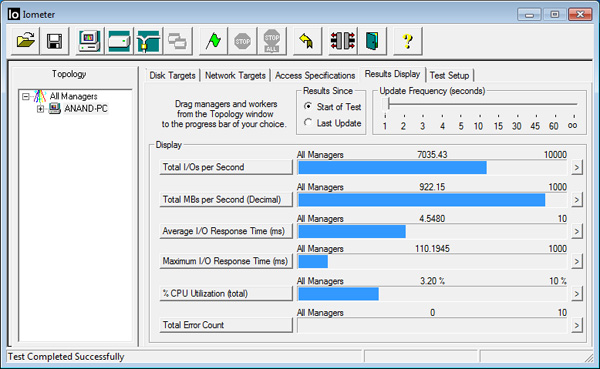
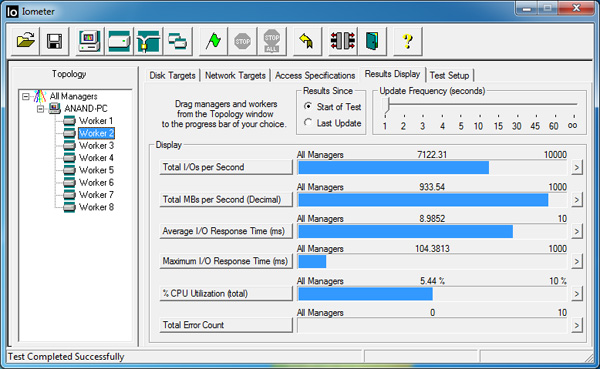
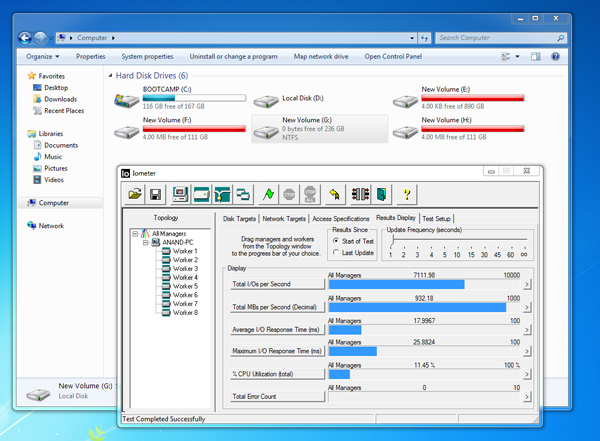
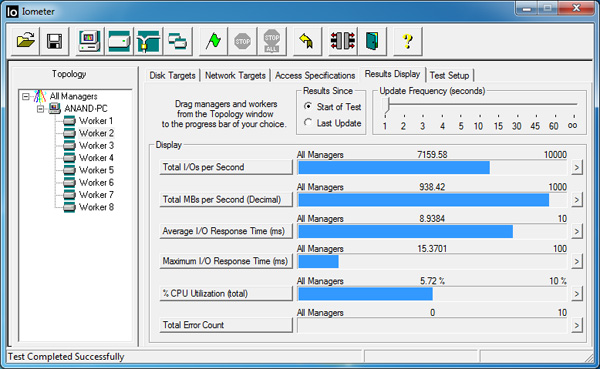
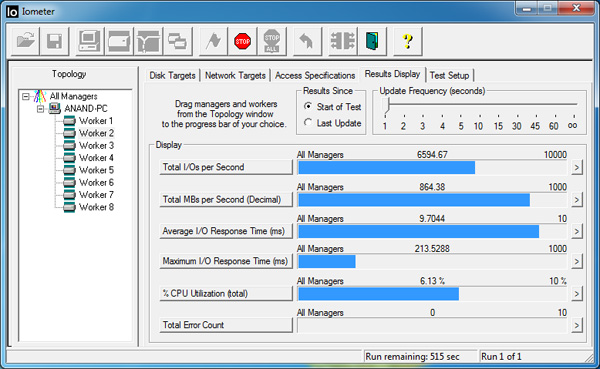
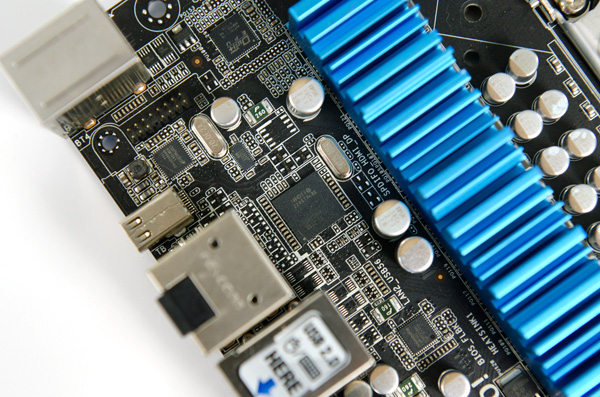
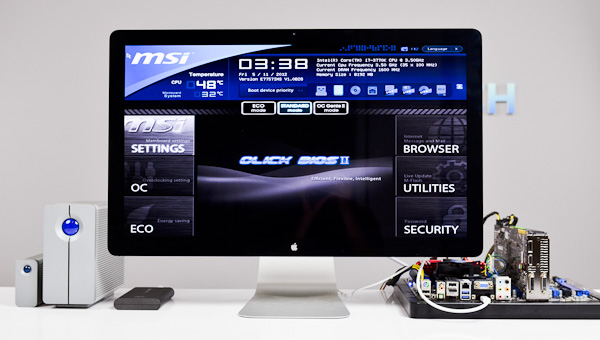
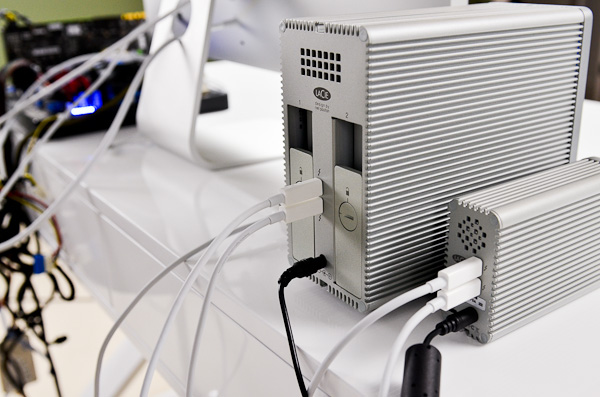








116 Comments
View All Comments
Pneumothorax - Monday, June 4, 2012 - link
I'm a heavy mac user with 2011 MBA, MBP, and 27 imac. AND I currently hate the implementation of TB. As of now you still can't get a TB hard drive for <$300 without gerry-rigging the seagate adapter with a 2.5" HDD as it also has problems with many SSD's. Very bitter as I drank the Apple kool-aid expecting wide-spread adoption after waiting over a year.repoman27 - Monday, June 4, 2012 - link
Skepticism about Thunderbolt is perfectly fine. Debating its merits versus the alternatives also fine.In the middle of an already polarized thread, posting statements devoid of a single valid premise could be considered trolling. The same goes for stereotyping and attacking a particular group, e.g. all Mac users.
I probably spend too much time "defending" Thunderbolt, but it has little to do with Apple pushing it. I primarily use laptops, and often wish for higher bandwidth I/O solutions than ExpressCard can provide, so I've been following the technology closely.
SamuraiArtGuy - Tuesday, June 12, 2012 - link
Apple is very conspicuously positioning Thunderbolt as the new "everything" high-speed port...Was interesting to note on the new (very Pro-class priced) retina Macbook Pro... no more Fire Wire, no Ethernet, no optical drive. Apple figures we're DONE with all that. (we'll see.. I've a stack of FW devices ) But they DO include USB 3 (which they get essentially for free with Ivy Bridge ) and rather interestingly, an HDMI port.
B3an - Sunday, June 3, 2012 - link
Does Win 8 natively support Thunderbolt? Like it now does with USB 3.0. As in, it no longer needs 3rd party drivers so will just immediately work on a clean install.ananduser - Sunday, June 3, 2012 - link
No, Windows does not support TB and MS has claimed that it will never support TB natively(for the time being) because it is plagued with security issues. Of course a hypothetical massive adoption of the interface might lead to native support. So it's safe to say that if things don't improve in the driver sector TB will remain a niche as FW.Penti - Sunday, June 3, 2012 - link
Why are you trolling? TB is just PCIe, the only issue is hotplug. Windows support hotplug just fine. Prior drivers or BIOS/Firmware might not. It's no more of a security risk then a Expresscard slot which lots of business PC's has. Or for that matter any internal Mini PCI Express slots. Or firewire. Or for that matter USB which is also exploitable to some degree. It's not up to Microsoft or Apple to decide which Thunderbolt appliance they support. Your fully capable to install the drivers yourself. For professional users with notebooks FW or Expresscard definitively isn't an option they need the extra bandwidth it provides for their tools/hardware to work. Without it they need to go to desktop/workstation towers. So there will be strong support. Most hardware won't be supported natively in Windows. If standard drivers works with your device it will work fine no matter OS, those might be shipped with the OS and some might not.They have no reason to differentiate drivers supporting hotplug with TB and not/old ways of doing things. When support is rolled in it's there. No different to what it has always been. Then again it's not about support for TB but the actual hardware you connect so the question is kinda wrong. There are Thunderbolt devices which don't work natively without 3rd party drivers for OS X too. So I don't see the fuss. External drives won't really move between OS's any way because Windows won't read HFS+ volumes and wise versa with NTFS pretty much. As long as the sata controller receives support your fine though.
B3an - Sunday, June 3, 2012 - link
I obviously only asked if Win 8 will natively support the Thunderbolt chipset controller. I don't care bout anything else. Win 8 now works with the USB 3.0 controller on my motherboard, so I dont have to install 3rd party drivers for it to function and be recognised in Device Manager. It would be convenient to have the same native support with Thunderbolt is all. So it just works.And a lot the time you don't have to install drivers for USB hardware, for instance most types of USB storage, printers and wifi cards do not need any 3rd party driver to function on Win 8 RP. If MS natively supported Thunderbolt I'd expect the same for many TB devices as well, especially storage.
Besides, Win 8 has drivers for tens of thousands of devices. It correctly installed display drivers for my CrossFire 6870's, webcam, USB devices, and even everything for my high-end motherboard.
Penti - Sunday, June 3, 2012 - link
The Thunderbolt chip and protocol is fully transparent, it's just a PCIe bridge/switch and transport solution. The OS never sees it as some odd device. In practice it no different then that Expresscard adapters need to support hot plug when it comes to consumer stuff. Some hardware always requires third party drivers, it does on Mac too. There is no difference here between Macs support and OEM PC vendors support.OEM-drivers and so on won't be shipped by Microsoft with Windows and lot of the drivers are lite versions not containing the full functionality.
USB-hardware normally don't need any drivers because they conform to HID, Mass-storage or MTP standards. Those standards are built into the USB-stack and the USB device only speaks the USB protocol and standards. It's kinda like supporting TCP/IP. Other devices often need drivers for full functionality but limited functionality drivers are usually already there. It was in Windows 7 and so on too. Network drivers and so on has been included in some form for decades in Windows.
In a short answer it already has support for the Thunderbolt chipset. It might not have support for the Thunderbolt device, but that is fully up to the developer / vendor as usual. Thunderbolt isn't a storage interface, Microsoft might support the SATA controller used just as they might support a Expresscard adapter for storage usage, might support your on-board PCIe controllers, or they might use a chip that has no Windows support yet to speak of or is newer then anything Microsoft has packaged with their software. We have supported hot plug of PCI devices all the time pretty much. There has always been issues when the hardware added to those don't support it properly or the drivers don't, or BIOS/firmware issues nothing new here. It's exactly the same thing as an internal PCIe card, or an Expresscard adapter or any integrated PCIe solution. As long as there is driver support (and no BIOS/firmware issues) it works fine. There is no controller for the OS to speak with here, it's not like USB or Firewire, the OS speaks directly to the hardware. It already knows how to speak over the PCIe bus.
Plenty of stuff will never get Windows 8 drivers for that matter. Mostly older stuff however.
If Lacie or Promise had used old SATA2-controllers they might already had worked on Windows. TB don't complicate it any more then an ExpressCard to eSATA adapter. In fact there is even ExpresCard-cabinettes for Thunderbolt. It's mainly a feature of PCIe which Windows already has native support for when it comes to the actual Thunderbolt solution. I obviously answered the troll, and also said that your question was the wrong one. The hardware will show up as native hardware. When that native hardware is supported you will have support. It just works if you have the PMC-Sierra/Promise drivers just as the article says. There is nothing more to it when it comes to the OS at least.
Apple probably will provide support for their stuff at some point because they support bootcamp. So look for any drivers there at whatever point they decide to do this.
ananduser - Monday, June 4, 2012 - link
Why are you so passionate about TB? I recall a specific statement by MS that they won't natively support TB. They do support USB natively. The article itself claims that there are some driver/firmware issues needing ironing out.Stop calling people names next time.
Penti - Friday, June 8, 2012 - link
Please provide information and a reference instead of your baseless FUD. Microsoft does support hot plug on PCIe and PCI bridge devices. There is nothing exotic about PCIe. Or extending it externally. They won't stop Thunderbolt working natively, I'm sure some of the drivers included works with it just fine. It's just the same thing as custom USB-devices will need their own drivers when it comes to the actual devices, there is no Thunderbolt driver to be had. The drivers will be the same as if it was a expresscard adapter or some such. If the PCIe controller drivers (which might be there, might not) support it, and supports hotplug it will work with no effort. The difference here is there needs to be a USB-driver supporting the USB-chipset/controller. That drivers happens to be universal against the USB spec, nothing strange. I haven't called anyone names, you where committing an act it should be described as such.Intel validates and certifies Thunderbolt for Windows PC's so how do you think it would not work or wouldn't be supported and what do you get out of suggesting it won't support it. Or that it would be for any security issue which also plagues Expresscard, Firewire, accessible Mini PCIe slots and to some degree buggy USB-drivers. There is no stance against the PCI bridge that TB is here. PCI-bridges are used inside platform chipsets and so on and Windows wouldn't work without supporting them.
So BIOS/UEFI problems with hot plugging and lacking drivers for peripherals under the Intel Thunderbolt certification program will solve those issues on any hardware with official support made for Windows. Those hasn't officially released yet and unsupported stuff will of course work less better. Apple eventually has to be on the game too but they will lag behind when it comes to compatibility (ACPI issues mainly) under Bootcamp / Compatibility Mode. You don't need to change the OS or to support any "controller" to fix those issues. After all they managed to do it with PCMCIA, CardBus, ExpressCard and so on. Technically it is the same and supported by the same standard as hotplugging other PCIe devices like Expresscard which BIOS/UEFI (standards need to be implemented, but they largely are already) and Windows does support. It's no new technology there to be seen by the OS or Firmware. Thunderbolt are transparent and invisible in that sense, just as it's the network drivers that talks Ethernetframes and not the OS TCP/IP stack. The thunderbolt transport isn't visible and there is no controller for the hardware that needs any drivers/tunneling it's just PCIe bridges and switches. It just falls under the PCIe root complex of the cpu. No nothing stranger.